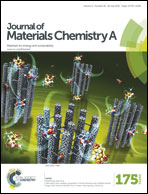Inkjet-printed porphyrinic metal–organic framework thin films for electrocatalysis†
Abstract
In this study, a simple and effective direct inkjet printing method was developed to prepare porphyrinic metal–organic framework (MOF) thin films for electrocatalysis. First, crystals of a zirconium-based porphyrinic MOF (MOF-525) with crystal sizes ranging from 100 to 700 nm were synthesized by adjusting the content of benzoic acid in a solvothermal synthetic process. The synthesized crystals showed a similar surface area of 2500 m2 g−1 with a unique pore size of 1.85 nm. However, some structural defects were found in the smallest crystals of 100 nm due to the fast crystallization process. After being suspended in dimethylformamide, the MOF crystal suspensions were inkjet printed to fabricate uniform MOF-525 thin film patterns. With the help of great precision in liquid deposition, the thicknesses of the printed MOF-525 thin films can be accurately controlled by the number of printed layers. With smaller crystal sizes, the printed MOF thin films showed more compact stacking and better contact with the substrate. The printed MOF thin films were applied for electrocatalytic nitrite oxidation. The effects of both film thickness and crystal size on the printed film morphology and electrocatalytic activity were investigated in detail. The printed MOF nitrite sensor showed a great detection limit of 0.72 μM and a high sensitivity of 40.6 μA mM−1 cm−2. In summary, this study demonstrated the feasibility of the proposed printing process for electrochemically addressable MOF thin films and can be further applied for many other electrochemical applications.


 Please wait while we load your content...
Please wait while we load your content...